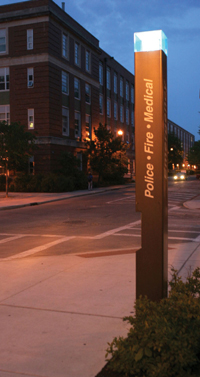Ohio State’s latest student safety initiative doesn’t involve adding more blue lights around campus, and it isn’t something you’ll see in a police patrol car. It’s something that could be as easy to access as reaching into your pocket.
Members of the Undergraduate Student Government are researching the possibility of a new OSU safety mobile app or “mobile blue light” as part of the organization’s effort to increase campus safety, said USG President Celia Wright, a fourth-year in public health.
Yet, USG director of health and safety DaVonti’ Haynes, a third-year in public affairs, said the name of the new app and the name of its developing company are confidential.
The new app is the most recent development in a more than year-long search for mobile-based solutions to on- and off-campus crime, Haynes said. The search began over the summer after USG discovered issues with a different safety app it had tested, LifeLine Response EDU, he said.
Although USG confirmed that the new app is capable of detection features that the LifeLine Response app was not, logistics such as funding and price will need to be worked out before USG releases the app’s name and developing company, Haynes said.
Still, Wright said USG is not ruling out any specific companies.
“We’re still working with public safety to determine which app will make students most safe, at the best value,” she said. “No decisions have been made yet, and no options have been eliminated, moving forward.”
Wright said the new app will function similarly and have the same features as the LifeLine Response app, but will have better accuracy in detecting the altitude of a student’s location.
“We really liked the idea of the (LifeLine) app, but we realized one issue from the pilot,” Wright said. “It could be really effective in off-campus streets but, for example, if someone was in Lincoln Tower and used the app, emergency personnel would have no idea on which level they were or if they were in a parking garage or something like that.”
Haynes said USG is looking into the possibility of a fee that would be paid by the university would pay to ensure that OSU students could download the app for free.
The LifeLine Response app would have cost students $8.99 on iTunes with a $7.99 fee for a one-year subscription, according to a 2013 interview with USG members. During the LifeLine Response app pilot program in 2013, the amount USG paid for the app was not disclosed because of confidentiality.
Haynes said, though, USG was working with the new app’s developing company to reduce the fee to students.
“USG is against adding a fee to students,” Haynes said. “The university as a whole would pay a fee to make the app accessible to any OSU affiliates.”
Wright said there will be no student trial pilot program as there was with the LifeLine Response app because USG has already gauged student interest in mobile safety initiatives.
“The idea of the app itself was highlighted last time because it was a new thing and we weren’t sure if students would like it as much as we thought they would,” Wright said. “From that experience, we concluded that students do want an app, so I think that the highlighting wouldn’t be necessary this time.”
But some students remain skeptical.
“I don’t think that making a free app is going to change anything,” said Amy Sharn, a second-year in chemistry. “I think it’s a good measure, but if you have your phone set up with a GPS signal, you can share your location with other people.”
Sam Seelbach, a third-year in biomedical engineering, disagreed though. “It’s not 100 percent foolproof, but it could definitely help a lot,” he said.
Wright said USG’s pursuit of the new app means moving in the right direction toward greater campus safety.
“This has been a long standing priority of USG,” Wright said. “We need to do what we can to prove to current and prospective students that Columbus is a great place to live and Ohio State is a safe place to be.”
Members of USG will attend another demonstration for the app some time before winter break and plan to have the app available to incoming students at the 2015 fall orientation, Haynes said.



